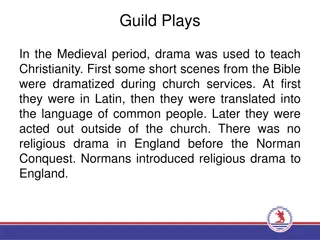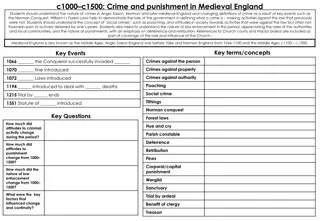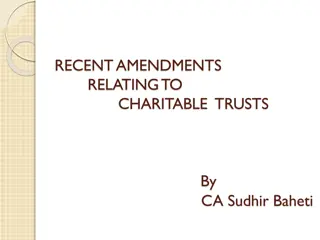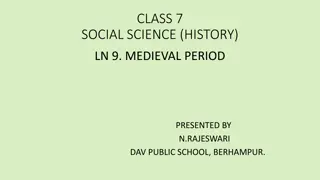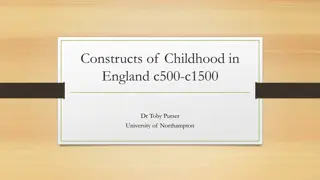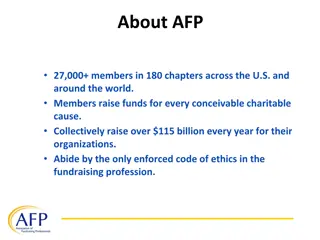Evolution of Charitable Practices in Medieval England
In medieval England, the concept of charity evolved from a focus on spiritual salvation to encompass helping the destitute. Initially undertaken by religious institutions and guilds, relief efforts eventually involved the state through laws like the Statute of Laborers in response to societal changes. This transition marked a shift towards organized welfare and support for various categories of the poor, illustrating the changing landscape of social assistance in the country.
Download Presentation

Please find below an Image/Link to download the presentation.
The content on the website is provided AS IS for your information and personal use only. It may not be sold, licensed, or shared on other websites without obtaining consent from the author.If you encounter any issues during the download, it is possible that the publisher has removed the file from their server.
You are allowed to download the files provided on this website for personal or commercial use, subject to the condition that they are used lawfully. All files are the property of their respective owners.
The content on the website is provided AS IS for your information and personal use only. It may not be sold, licensed, or shared on other websites without obtaining consent from the author.
E N D
Presentation Transcript
Early Charities In England History of Welfare Development in UK
Medieval Period In medieval England, as elsewhere, since the main motive for alms giving was the salvation of the donor s soul, there was usually little concern with the human being who received the charity. Beginning in the fourteenth century, however, some distinction was made between two classes of the poor: the able-bodied poor, who could earn their living, and the impotent poor, who were unable to work-the blind, the lame, the aged, the sick, young children, and pregnant women. Relief to the destitute was first distributed by the priest of the parish, with the help of the churchwardens and deacons.
In the thirteenth and fourteenth centuries, religious orders and church institutions relieved the parish churches from most of the duties of caring for the poor. In the fifteenth century more than a thousand monasteries, convents, hospitals, and abbeys provided shelter, clothes, food, and alms for the poor and for wandering beggars. From the twelfth to the fifteenth century, the relief activities of the church were supplemented by charities sponsored by the guilds. These guilds were organized primarily by working men for mutual self-help, brotherhood, and fellowship.
The king and Parliament did not concern themselves with the distribution of charity until the fourteenth century. Under the feudal system, the serfs and their families were fed and clad by the lord and cared for by the lady when they were old or sick. With the disappearance of feudalism and rise of a new order which freed the serfs and employed agricultural labor for wages, the king and the nobility faced the problem of how to maintain order among the laborers and prevent vagrancy and crime. At the beginning of Industrial Revolution, the manufacture of wool opened some work to the laborer, but resident workers were hired first.
First Poor Law The first poor law in England was based on a national catastrophe. In 1348 the Black Death killed two-thirds of the English population within two years. It caused a severe shortage of labor on the manors and resulted in a steep rise in wages. In 1349, Edward III ordered that able-bodied laborers without means must accept employment from any master willing to hire them and forbade them to leave their parish. Citizens were not allowed to give alms to able-bodied beggars. Edward s Statute of Laborers was designed to prevent vagrancy and begging and force the rural worker to stay on the land through cruel punishments.
Statute of Henry VIII in 1531 The first constructive measure taken by government for the relief of the poor was the Statute of Henry VIII in 1531. It provided that mayors and justices of the peace should investigate applications of the aged and paupers unable to work who were maintained by the parish. They were to be registered and licensed to beg in an assigned area. This law was the beginning of a recognition of public responsibility for the poor.
Statute of 1536 The Statute of 1536 established the first plan of public relief under the auspices of the government in England. It ruled that paupers could be registered in their parishes only after they had resided for three years in the county. Able-bodied beggars were forced to work, and idle children from five to fourteen age were taken away from their parents and indentured.
Statute of Artificers In 1562 the Statute of Artificers was issued to regulate wages and hours of labor and increase the skill of artisans by an apprentice system. It required that vagrants and vagabonds be put to hard labor and that unemployed beggars between twelve and sixty years of age be hired out as servants. In 1563 Parliament had to adopt compulsory measures to finance parish poor relief. Each householder was compelled by law to make a weekly contribution based on property and income.
Statute of 1572 The Statute of 1572, signed by Queen Elizabeth I, introduced a general tax to provide funds for poor relief and established overseers of the poor to administer the new law. This statute marked the final recognition that the government was responsible for providing aid to people who could not maintain themselves. In 1576, houses of correction, supplied with wool, hemp, flax, and iron, were established in which the able-bodied poor, particularly young persons, were forced to work.
Statute of 1597 The Statute churchwardens and four substantial householders were to be appointed as overseers of the poor by the justices of the peace. Almshouses were to be erected for the old, the blind, the lame, and those unable to work, and parents and children were made liable for each other s maintenance. confirmed that the of 1597
Source: Book title Introduction to Social Welfare Author: Walter A. Friedlander Robert Z. Apte







